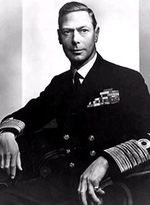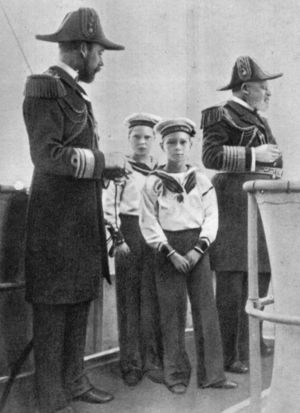جورج السادس من المملكة المتحدة
| جورج السادس George VI | |
|---|---|
| King of Great Britain, Ireland and the British dominions beyond the Seas; Emperor of India (more...) | |

| |
| الپورتريه الرسمي، حوالي 1940–46. | |
| الحكم | 11 ديسمبر 1936 – 6 فبراير 1952 امبراطور الهند: 1936–47 ملك أيرلندا: 1936–49 |
| التتويج | 12 مايو 1937 |
| سلفه | إدوارد الثامن |
| خليفته | إلزابث الثانية |
| Consort | |
| الأنجال | |
| الاسم الكامل | |
| Albert Frederick Arthur George | |
| الألقاب والأنماط | |
| HM الملك HRH دوق يورك HRH الأمير ألبرت HRH الأمير ألبرت من ويلز HRH الأمير ألبرت من كورنوال ويورك HRH الأمير ألبرت من يورك HH الأمير ألبرت من يورك | |
| البيت الملكي | بيت ونزر |
| النشيد الملكي | God Save the King |
| الأب | George V |
| الأم | Mary of Teck |
| وُلد | 14 ديسمبر 1895 ساندرنگهام، نورفوك، إنگلترة |
| عـُـمـِّد | 17 فبراير 1896 St. Mary Magdalene's Church, ساندرنگهام، إنگلترة |
| توفي | 6 فبراير 1952 (aged 56) ساندرنگهام، نورفوك، إنگلترة |
| المدفن | 15 فبراير 1952 St George's Chapel, ونزر، إنگلترة |
جورج السادس (George VI) عاش (14 ديسمبر 1895 - 6 فبراير 1952) هو ملك بريطانيا العظمى وآيرلندا (1936-1952 م) وآخر أباطرة الهند (1936-1947 م)، كان الابن الثاني لوالده الملك جورج الخامس كان لقبه الرسمي قبل التتويج الأمير ألبرت دوق إدنبره.
حل محل أخيه الملك إدوارد الثامن على رأس التاج البريطاني عندما تخلى الأخير ومن تلقاء نفسه عن العرش. شاركت بريطانيا أثناء حكمه في الحرب العالمية الثانية، وخرجت منها منتصرة. اتخذ مع عائلته موقفا شجاعا عندما قرروا البقاء في لندن أثناء الغارات الجوية الألمانية، اعتبر موقفه رمزا للصمود البريطاني، وحظي الملك باحترام الشعب.
The future George VI was born in the reign of his great-grandmother Queen Victoria; he was named Albert at birth after his great-grandfather Albert, Prince Consort, and was known as "Bertie" to his family and close friends. His father ascended the throne as George V in 1910. As the second son of the king, Albert was not expected to inherit the throne. He spent his early life in the shadow of his elder brother, Prince Edward, the heir apparent. Albert attended naval college as a teenager and served in the Royal Navy and Royal Air Force during the First World War. In 1920, he was made Duke of York. He married Lady Elizabeth Bowes-Lyon in 1923, and they had two daughters, Elizabeth and Margaret. In the mid-1920s, he engaged speech therapist Lionel Logue to treat his stammer, which he learned to manage to some degree. His elder brother ascended the throne as Edward VIII after their father died in 1936, but Edward abdicated later that year to marry the twice-divorced American socialite Wallis Simpson. As heir presumptive to Edward VIII, Albert thereby became the third monarch of the House of Windsor, taking the regnal name George VI.
In September 1939, the British Empire and most Commonwealth countries—but not Ireland—declared war on Nazi Germany. War with the Kingdom of Italy and the Empire of Japan followed in 1940 and 1941, respectively. George VI was seen as sharing the hardships of the common people and his popularity soared. Buckingham Palace was bombed during the Blitz while the King and Queen were there, and his younger brother the Duke of Kent was killed on active service. George became known as a symbol of British determination to win the war. Britain and its allies were victorious in 1945, but the British Empire declined. Ireland had largely broken away, followed by the independence of India and Pakistan in 1947. George relinquished the title of Emperor of India in June 1948 and instead adopted the new title of Head of the Commonwealth. He was beset by smoking-related health problems in the later years of his reign and died of a coronary thrombosis in 1952. He was succeeded by his elder daughter, Elizabeth II.
النشأة
The future George VI was born at York Cottage, on the Sandringham Estate in Norfolk, during the reign of his great-grandmother Queen Victoria.[1] His father was Prince George, Duke of York (later King George V), the second and eldest surviving son of the Prince and Princess of Wales (later King Edward VII and Queen Alexandra). His mother, the Duchess of York (later Queen Mary), was the eldest child and only daughter of Francis, Duke of Teck, and Mary Adelaide, Duchess of Teck.[2] His birthday, 14 December 1895, was the 34th anniversary of the death of his great-grandfather Albert, Prince Consort.[3] Uncertain of how the Prince Consort's widow, Queen Victoria, would take the news of the birth, the Prince of Wales wrote to the Duke of York that the Queen had been "rather distressed". Two days later, he wrote again: "I really think it would gratify her if you yourself proposed the name Albert to her."[4]
الزواج
|
Reluctant king
King George V had severe reservations about Prince Edward, saying "After I am dead, the boy will ruin himself in twelve months" and "I pray God that my eldest son will never marry and that nothing will come between Bertie and Lilibet and the throne."[5] On 20 January 1936, George V died and Edward ascended the throne as King Edward VIII. In the Vigil of the Princes, Prince Albert and his three brothers (the new king, Prince Henry, Duke of Gloucester, and Prince George, Duke of Kent) took a shift standing guard over their father's body as it lay in state, in a closed casket, in Westminster Hall.
As Edward was unmarried and had no children, Albert was the heir presumptive to the throne. Less than a year later, on 11 December 1936, Edward abdicated in order to marry Wallis Simpson, who was divorced from her first husband and divorcing her second. Edward had been advised by British prime minister Stanley Baldwin that he could not remain king and marry a divorced woman with two living ex-husbands. He abdicated and Albert, though he had been reluctant to accept the throne, became king.[6] The day before the abdication, Albert went to London to see his mother, Queen Mary. He wrote in his diary, "When I told her what had happened, I broke down and sobbed like a child."[7]
On the day of Edward's abdication, the Oireachtas, the parliament of the Irish Free State, removed all direct mention of the monarch from the Irish constitution. The next day, it passed the External Relations Act, which gave the monarch limited authority (strictly on the advice of the government) to appoint diplomatic representatives for Ireland and to be involved in the making of foreign treaties. The two acts made the Irish Free State a republic in essence without removing its links to the Commonwealth.[8]
Across Britain, gossip spread that Albert was physically and psychologically incapable of being king. No evidence has been found to support the contemporaneous rumour that the government considered bypassing him, his children and his brother Henry, in favour of their younger brother George, Duke of Kent.[9] This seems to have been suggested on the grounds that George was at that time the only brother with a son.[10]
Early reign
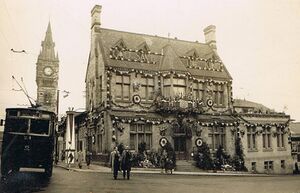
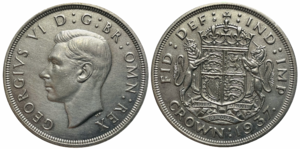
Albert assumed the regnal name "George VI" to emphasise continuity with his father and restore confidence in the monarchy.[11] The beginning of George VI's reign was taken up by questions surrounding his predecessor and brother, whose titles, style and position were uncertain. He had been introduced as "His Royal Highness Prince Edward" for the abdication broadcast,[12] but George VI felt that by abdicating and renouncing the succession, Edward had lost the right to bear royal titles, including "Royal Highness".[13] In settling the issue, George's first act as king was to confer upon his brother the title "Duke of Windsor" with the style "Royal Highness", but the letters patent creating the dukedom prevented any wife or children from bearing royal styles. George VI was forced to buy from Edward the royal residences of Balmoral Castle and Sandringham House, as these were private properties and did not pass to him automatically.[14] Three days after his accession, on his 41st birthday, he invested his wife, the new queen consort, with the Order of the Garter.[15]
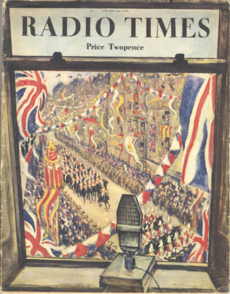
George VI's coronation at Westminster Abbey took place on 12 May 1937, the date previously intended for Edward's coronation. In a break with tradition, his mother Queen Mary attended the ceremony in a show of support for her son.[16] There was no Durbar held in Delhi for George VI, as had occurred for his father, as the cost would have been a burden to the Government of India.[17] Rising Indian nationalism made the welcome that the royal party would have received likely to be muted at best,[18] and a prolonged absence from Britain would have been undesirable in the tense period before the Second World War. Two overseas tours were undertaken, to France and to North America, both of which promised greater strategic advantages in the event of war.[19]
The growing likelihood of war in Europe dominated the early reign of George VI. The King was constitutionally bound to support Prime Minister Neville Chamberlain's appeasement of Hitler.[20][21] When the King and Queen greeted Chamberlain on his return from negotiating the Munich Agreement in 1938, they invited him to appear on the balcony of Buckingham Palace with them. This public association of the monarchy with a politician was exceptional, as balcony appearances were traditionally restricted to the royal family.[20] While broadly popular among the general public, Chamberlain's policy towards Hitler was the subject of some opposition in the House of Commons, which led historian John Grigg to describe the King's behaviour in associating himself so prominently with a politician as "the most unconstitutional act by a British sovereign in the present century".[22]

In May and June 1939, the King and Queen toured Canada and the United States; it was the first visit of a reigning British monarch to North America, although he had been to Canada prior to his accession. From Ottawa, they were accompanied by the Canadian prime minister, William Lyon Mackenzie King,[23] to present themselves in North America as King and Queen of Canada.[24][25] Both Governor General of Canada Lord Tweedsmuir and Mackenzie King hoped that the King's presence in Canada would demonstrate the principles of the Statute of Westminster 1931, which gave full sovereignty to the British Dominions. On 19 May, George VI personally accepted and approved the Letter of Credence of the new U.S. Ambassador to Canada, Daniel Calhoun Roper; gave Royal Assent to nine parliamentary bills; and ratified two international treaties with the Great Seal of Canada. The official royal tour historian, Gustave Lanctot, wrote "the Statute of Westminster had assumed full reality" and George gave a speech emphasising "the free and equal association of the nations of the Commonwealth".[26]
The trip was intended to soften the strong isolationist tendencies among the North American public with regard to the developing tensions in Europe. Although the aim of the tour was mainly political, to shore up Atlantic support for the United Kingdom in any future war, the King and Queen were enthusiastically received by the public.[27] The fear that George would be compared unfavourably to his predecessor was dispelled.[28] They visited the 1939 New York World's Fair and stayed with President Franklin D. Roosevelt at the White House and at his private estate at Hyde Park, New York.[29] A strong bond of friendship was forged between the King and Queen and the President during the tour, which had major significance in the relations between the United States and the United Kingdom through the ensuing war years.[30][31]
الحرب العالمية الثانية
Following the German invasion of Poland in September 1939, the United Kingdom and the self-governing Dominions other than Ireland declared war on Nazi Germany.[32] George VI and his wife resolved to stay in London, despite German bombing raids. They officially stayed in Buckingham Palace throughout the war, although they usually spent nights at Windsor Castle.[33] The first night of the Blitz on London, on 7 September 1940, killed about one thousand civilians, mostly in the East End.[34] On 13 September, the King and Queen narrowly avoided death when two German bombs exploded in a courtyard at Buckingham Palace while they were there.[35] In defiance, the Queen declared: "I am glad we have been bombed. It makes me feel we can look the East End in the face."[36] The royal family were portrayed as sharing the same dangers and deprivations as the rest of the country. They were subject to British rationing restrictions, and U.S. First Lady Eleanor Roosevelt remarked on the rationed food served and the limited bathwater that was permitted during a stay at the unheated and boarded-up Palace.[37] In August 1942, the King's brother, the Duke of Kent, was killed on active service.[38]
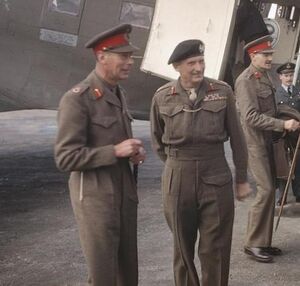
In 1940, Winston Churchill replaced Neville Chamberlain as prime minister, though personally George would have preferred to appoint Lord Halifax.[39] After the King's initial dismay over Churchill's appointment of Lord Beaverbrook to the Cabinet, he and Churchill developed "the closest personal relationship in modern British history between a monarch and a Prime Minister".[40] Every Tuesday for four and a half years from September 1940, the two men met privately for lunch to discuss the war in secret and with frankness.[41] The King related much of what the two discussed in his diary, which is the only extant first-hand account of these conversations.[42]
Throughout the war, the King and Queen provided morale-boosting visits throughout the United Kingdom, visiting bomb sites, munitions factories, and troops. The King visited military forces abroad in France in December 1939, North Africa and Malta in June 1943, Normandy in June 1944, southern Italy in July 1944, and the Low Countries in October 1944.[43] Their high public profile and apparently indefatigable determination secured their place as symbols of national resistance.[44] At a social function in 1944, the Chief of the Imperial General Staff, Field Marshal Alan Brooke, revealed that every time he met Field Marshal Bernard Montgomery, he thought Montgomery was after his job. The King replied: "You should worry, when I meet him, I always think he's after mine!"[45]
In 1945, crowds shouted "We want the King!" in front of Buckingham Palace during the Victory in Europe Day celebrations. In an echo of Chamberlain's appearance, the King invited Churchill to appear with the royal family on the balcony to public acclaim.[46] In January 1946, George addressed the United Nations at its first assembly, which was held in London, and reaffirmed "our faith in the equal rights of men and women and of nations great and small".[47]
من امبراطورية إلى كومنولث

George VI's reign saw the acceleration of the dissolution of the British Empire. The Statute of Westminster 1931 had already acknowledged the evolution of the Dominions into separate sovereign states. The process of transformation from an empire to a voluntary association of independent states, known as the Commonwealth, gathered pace after the Second World War.[48] During the ministry of Clement Attlee, British India became the two independent Dominions of India and Pakistan in August 1947.[49] George relinquished the title of Emperor of India,[50] and became King of India and King of Pakistan instead. In late April 1949, the Commonwealth leaders issued the London Declaration, which laid the foundation of the modern Commonwealth and recognised the King as Head of the Commonwealth.[51][52][53] In January 1950, he ceased to be King of India when it became a republic, and remained King of Pakistan until his death. Other countries left the Commonwealth, such as Burma in January 1948, Palestine (divided between Israel and the Arab states) in May 1948 and the Republic of Ireland in 1949.[54]
In 1947, the King and his family toured southern Africa.[55] The prime minister of the Union of South Africa, Jan Smuts, was facing an election and hoped to make political capital out of the visit.[56] George was appalled, however, when instructed by the South African government to shake hands only with whites,[57] and referred to his South African bodyguards as "the Gestapo".[58] Despite the tour, Smuts lost the election the following year, and the new government instituted a strict policy of racial segregation.
المرض والوفاة
The stress of the war had taken its toll on the King's health,[59][60] made worse by his heavy smoking[61] and subsequent development of lung cancer among other ailments, including arteriosclerosis and Buerger's disease. A planned tour of Australia and New Zealand was postponed after the King suffered an arterial blockage in his right leg, which threatened the loss of the leg and was treated with a right lumbar sympathectomy in March 1949.[62] His elder daughter Elizabeth, the heir presumptive, took on more royal duties as her father's health deteriorated. The delayed tour was re-organised, with Elizabeth and her husband, Philip, Duke of Edinburgh, taking the place of the King and Queen.
The King was well enough to open the Festival of Britain in May 1951, but on 4 June it was announced that he would need immediate and complete rest for the next four weeks, despite the arrival of Haakon VII of Norway the following afternoon for an official visit.[63] On 23 September 1951, he underwent a surgical operation where his entire left lung was removed by Clement Price Thomas after a malignant tumour was found.[64] In October 1951, Elizabeth and Philip went on a month-long tour of Canada; the trip had been delayed for a week due to the King's illness. At the State Opening of Parliament in November, the King's speech from the throne was read for him by the Lord Chancellor, Lord Simonds.[65] His Christmas broadcast of 1951 was recorded in sections, and then edited together.[66]
On 31 January 1952, despite advice from those close to him, the King went to London Airport[أ] to see Elizabeth and Philip off on their tour to Australia via Kenya. It was his last public appearance. Six days later, at 07:30 GMT on the morning of 6 February, he was found dead in bed at Sandringham House in Norfolk.[68] He had died in the night from a coronary thrombosis at the age of 56.[69] His daughter flew back to Britain from Kenya as Queen Elizabeth II.[70]
From 9 February George VI's coffin rested in St Mary Magdalene Church, Sandringham, before lying in state at Westminster Hall from 11 February.[71] His funeral took place at St George's Chapel, Windsor Castle, on the 15th.[72] He was interred initially in the Royal Vault until he was transferred to the King George VI Memorial Chapel inside St George's on 26 March 1969.[73] In 2002, fifty years after his death, the remains of his widow, Queen Elizabeth The Queen Mother, and the ashes of his younger daughter Princess Margaret, who both died that year, were interred in the chapel alongside him.[74] Twenty years later, following the death of his eldest daughter and heir, Queen Elizabeth II, her remains, and the remains of her husband, Prince Philip, Duke of Edinburgh, following his death in 2021, are planned to be interred in the chapel.
الذكرى
In the words of Labour Member of Parliament (MP) George Hardie, the abdication crisis of 1936 did "more for republicanism than fifty years of propaganda".[75] George VI wrote to his brother Edward that in the aftermath of the abdication he had reluctantly assumed "a rocking throne" and tried "to make it steady again".[76] He became king at a point when public faith in the monarchy was at a low ebb. During his reign, his people endured the hardships of war, and imperial power was eroded. However, as a dutiful family man and by showing personal courage, he succeeded in restoring the popularity of the monarchy.[77][78]
The George Cross and the George Medal were founded at the King's suggestion during the Second World War to recognise acts of exceptional civilian bravery.[79] He bestowed the George Cross on the entire "island fortress of Malta" in 1943.[80] He was posthumously awarded the Order of Liberation by the French government in 1960, one of only two people (the other being Churchill in 1958) to be awarded the medal after 1946.[81]
Colin Firth won an Academy Award for Best Actor for his performance as George VI in the 2010 film The King's Speech.[82]
Honours and arms
| Monarchical Styles of جورج السادس من المملكة المتحدة | |

| |
| Reference style | سموه |
|---|---|
| Spoken style | سموك |
| Alternative style | سيد |
توفي في فبراير 1952 بسبب سرطان الرئة، وحلت محله إبنته الملكه إليزابيث الثانية.
الأجداد
المراجع والملاحظات
- ^ Rhodes James, p. 90; Weir, p. 329
- ^ Weir, pp. 322–323, 329
- ^ Judd, p. 3; Rhodes James, p. 90; Townsend, p. 15; Wheeler-Bennett, pp. 7–8
- ^ Judd, pp. 4–5; Wheeler-Bennett, pp. 7–8
- ^ Ziegler, p. 199
- ^ Judd, p. 140
- ^ Wheeler-Bennett, p. 286
- ^ Townsend, p. 93
- ^ Bradford, p. 208; Judd, pp. 141–142
- ^ Howarth, p. 63; Judd, p. 135
- ^ Howarth, p. 66; Judd, p. 141
- ^ Judd, p. 144; Sinclair, p. 224
- ^ Howarth, p. 143
- ^ Ziegler, p. 326
- ^ Bradford, p. 223
- ^ Bradford, p. 214
- ^ Vickers, p. 175
- ^ Bradford, p. 209
- ^ Bradford, pp. 269, 281
- ^ أ ب خطأ استشهاد: وسم
<ref>غير صحيح؛ لا نص تم توفيره للمراجع المسماةmatthew - ^ Sinclair, p. 230
- ^ Hitchens, Christopher (1 April 2002), "Mourning will be brief" Archived 28 أكتوبر 2017 at the Wayback Machine, The Guardian, retrieved 1 May 2009
- ^ Library and Archives Canada, Biography and People > A Real Companion and Friend > Behind the Diary > Politics, Themes, and Events from King's Life > The Royal Tour of 1939, Queen's Printer for Canada, http://www.collectionscanada.gc.ca/king/023011-1070.06-e.html, retrieved on 12 December 2009
- ^ Bousfield, Arthur; Toffoli, Garry (1989), Royal Spring: The Royal Tour of 1939 and the Queen Mother in Canada, Toronto: Dundurn Press, pp. 60, 66, ISBN 978-1-55002-065-6, https://books.google.com/books?id=1Go5p_CN8UQC, retrieved on 21 September 2020
- ^ Lanctot, Gustave (1964), Royal Tour of King George VI and Queen Elizabeth in Canada and the United States of America 1939, Toronto: E.P. Taylor Foundation
- ^ Galbraith, William (1989), "Fiftieth Anniversary of the 1939 Royal Visit", Canadian Parliamentary Review 12 (3): 7–9, http://www.revparl.ca/english/issue.asp?art=820¶m=130, retrieved on 24 March 2015
- ^ Judd, pp. 163–166; Rhodes James, pp. 154–168; Vickers, p. 187
- ^ Bradford, pp. 298–299
- ^ The Times Monday, 12 June 1939 p. 12 col. A
- ^ Swift, Will (2004), The Roosevelts and the Royals: Franklin and Eleanor, the King and Queen of England, and the Friendship that Changed History, John Wiley & Sons
- ^ Judd, p. 189; Rhodes James, p. 344
- ^ Judd, pp. 171–172; Townsend, p. 104
- ^ Judd, p. 183; Rhodes James, p. 214
- ^ Arnold-Forster, Mark (1983), The World at War, London: Thames Methuen, p. 303, ISBN 978-0-423-00680-3
- ^ Churchill, Winston (1949), The Second World War, II, Cassell and Co. Ltd, p. 334
- ^ Judd, p. 184; Rhodes James, pp. 211–212; Townsend, p. 111
- ^ Goodwin, Doris Kearns (1994), No Ordinary Time: Franklin and Eleanor Roosevelt: The Home Front in World War II, New York: Simon & Schuster, p. 380
- ^ Judd, p. 187; Weir, p. 324
- ^ Judd, p. 180
- ^ Rhodes James, p. 195
- ^ Rhodes James, pp. 202–210
- ^ Weisbrode, Kenneth (2013), Churchill and the King, New York: Viking, pp. 107, 117–118, 148, 154–155, 166. ISBN 978-0670025763.
- ^ Judd, pp. 176, 201–203, 207–208
- ^ Judd, p. 170
- ^ Reagan, Geoffrey (1992), Military Anecdotes, Guinness, p. 25, ISBN 978-0-85112-519-0
- ^ Judd, p. 210
- ^ Townsend, p. 173
- ^ Townsend, p. 176
- ^ Townsend, pp. 229–232, 247–265
- ^ Published by Authority (18 June 1948). "A proclamation by the King, 22 June 1948". Supplement to the Belfast Gazette - Official Public Record (1408): 153. Archived from the original on 5 September 2021.
- ^ London Declaration 1949, Commonwealth Secretariat, https://thecommonwealth.org/sites/default/files/history-items/documents/London%20Declaration%20of%201949.pdf, retrieved on 2 April 2013
- ^ S. A. de Smith (1949), "The London Declaration of the Commonwealth Prime Ministers, April 28, 1949", The Modern Law Review 12 (3): 351–354, doi:
- ^ Queen Elizabeth II and the Royal Family: A Glorious Illustrated History, Dorling Kindersley, 2016, p. 118, ISBN 9780241296653
- ^ Townsend, pp. 267–270
- ^ Townsend, pp. 221–223
- ^ Judd, p. 223
- ^ Rhodes James, p. 295
- ^ Rhodes James, p. 294; Shawcross, p. 618
- ^ King George VI, Official website of the British monarchy, 12 January 2016, https://www.royal.uk/george-vi-r1936-1952, retrieved on 18 April 2016
- ^ Judd, p. 225; Townsend, p. 174
- ^ Judd, p. 240
- ^ Rhodes James, pp. 314–317
- ^ The King to rest, 5 June 1951, https://www.thetimes.co.uk/tto/archive/article/1951-06-05/4/17.html#start%3D1951-01-01%26end%3D1952-01-01%26terms%3D%22The%20king%22%20AND%20%22lung%22%26back%3D/tto/archive/find/%252522The+king%252522+AND+%252522lung%252522/w:1951-01-01%7E1952-01-01/o:date/2%26prev%3D/tto/archive/frame/goto/%252522The+king%252522+AND+%252522lung%252522/w:1951-01-01%7E1952-01-01/o:date/16%26next%3D/tto/archive/frame/goto/%252522The+king%252522+AND+%252522lung%252522/w:1951-01-01%7E1952-01-01/o:date/18
- ^ Bradford, p. 454; Rhodes James, p. 330
- ^ Rhodes James, p. 331
- ^ Rhodes James, p. 334
- ^ About Heathrow Airport: Heathrow's history, LHR Airports, http://www.heathrowairport.com/about-us/company-news-and-information/company-information/our-history, retrieved on 9 March 2015
- ^ 1952: King George VI dies in his sleep, BBC, 6 February 1952, http://news.bbc.co.uk/onthisday/hi/dates/stories/february/6/newsid_2711000/2711265.stm, retrieved on 29 May 2018
- ^ Judd, pp. 247–248
- ^ The day the King died, BBC, 6 February 2002, http://news.bbc.co.uk/2/hi/uk_news/1802079.stm, retrieved on 29 May 2018
- ^ "Repose at Sandringham", Life (Time Inc): 38, 18 February 1952, ISSN 0024-3019, https://books.google.com/books?id=dFQEAAAAMBAJ&pg=PA38, retrieved on 26 December 2011
- ^ Zweiniger‐Bargielowska, Ina (2016), "Royal death and living memorials: the funerals and commemoration of George V and George VI, 1936–52", Historical Research 89 (243): 158–175, doi:
- ^ Royal Burials in the Chapel since 1805, Dean & Canons of Windsor, http://www.stgeorges-windsor.org/about-st-georges/royal-connection/burial/burials-in-the-chapel-since-1805.html, retrieved on 15 February 2010
- ^ Mourners visit Queen Mother's vault, 10 April 2002, http://news.bbc.co.uk/1/hi/uk/1920360.stm, retrieved on 2 March 2018
- ^ Hardie in the British House of Commons, 11 December 1936, quoted in Rhodes James, p. 115
- ^ Letter from George VI to the Duke of Windsor, quoted in Rhodes James, p. 127
- ^ Ashley, Mike (1998), British Monarchs, London: Robinson, pp. 703–704, ISBN 978-1-84119-096-9
- ^ Judd, pp. 248–249
- ^ Judd, p. 186; Rhodes James, p. 216
- ^ Townsend, p. 137
- ^ List of Companions, Ordre de la Libération, http://www.ordredelaliberation.fr/fr_doc/liste_compagnons.pdf, retrieved on 19 September 2009
- ^ Brooks, Xan (28 February 2011). "Colin Firth takes the best actor crown at the Oscars". The Guardian (in الإنجليزية). Retrieved 17 August 2022.
وصلات خارجية
جورج السادس من المملكة المتحدة فرع أصغر من House of Wettin وُلِد: 14 December 1895 توفي: 6 February 1952
| ||
| ألقاب ملكية | ||
|---|---|---|
| سبقه Edward VIII |
King of the United Kingdom and British dominions beyond the seas 1936 – 1952 |
تبعه Elizabeth II |
| Emperor of India 1936 – 1947 |
Title removed by an Order-in-Council¹ on 22 June 1948 | |
| King of Ireland 1936 – 1949 |
تبعه Seán T. O'Kelly As president of the Republic of Ireland | |
| تبعه himself As the monarch in Northern Ireland | ||
| مناصب سياسية | ||
| لقب حديث | Head of the Commonwealth 1949 – 1952 |
تبعه Elizabeth II |
| الملكية البريطانية | ||
| سبقه Edward, Prince of Wales later became King Edward VIII, later known as Edward, Duke of Windsor |
Heir to the Throne as heir presumptive 20 January 1936 – 11 December 1936 |
تبعه Princess Elizabeth, Duchess of Edinburgh later became Queen Elizabeth II |
| مناصب ماسونية | ||
| سبقه Iain Colquhoun |
Grand Master of the Grand Lodge of Scotland 1936 – 1937 |
تبعه Norman Orr-Ewing |
| Peerage of the United Kingdom | ||
| منصب مستحدث | Duke of York 7th creation 1920 – 1936 |
Merged in the Crown |
| Notes and references | ||
| 1. www.heraldica.org | ||
المصادر
- Bradford, Sarah (1989). King George VI. London: Weidenfeld and Nicolson. ISBN 0-297-79667-4.
- Howarth, Patrick (1987). George VI. Hutchinson. ISBN 0-091-71000-6.
- Matthew, H. C. G. (2004), "George VI (1895–1952)", Oxford Dictionary of National Biography (Oxford University Press)
- Sinclair, David (1988). Two Georges: the Making of the Modern Monarchy. Hodder and Staughton. ISBN 0-340-33240-9.
- Wheeler-Bennett, Sir John (1958). King George VI: His Life and Reign. New York: Macmillan.
| قبله: إدوارد الثامن |
ملك المملكة المتحدة ودول الكومونولث 1936 |
بعده: إليزابيث الثانيه |
خطأ استشهاد: وسوم <ref> موجودة لمجموعة اسمها "lower-alpha"، ولكن لم يتم العثور على وسم <references group="lower-alpha"/>
- Articles with hatnote templates targeting a nonexistent page
- ملوك المملكة المتحدة
- ملوك أستراليا
- رؤوس دولة كندا
- رؤوس دولة نيوزيلندا
- ملوك جنوب أفريقيا
- ملوك سيلان
- رؤوس الكومنولث
- بيت ونزر
- Dukes in the Peerage of the United Kingdom
- دوقات يورك
- English and British princes
- Royal Navy admirals of the fleet
- مشيرون بريطانيون
- Marshals of the Royal Air Force
- Royal Navy personnel of World War I
- Royal Air Force personnel of World War I
- زعماء سياسيون في الحرب العالمية الثانية
- ملوك پروتستانت
- فرسان الوشاح
- Knights of the Thistle
- Knights of St Patrick
- Knights Grand Cross of the Order of St Michael and St George
- Knights Grand Cross of the Royal Victorian Order
- رفاق التحرير
- حائزو السلسلة الڤيكتورية الملكية
- زملاء ملكيون للجمعية الملكية
- Knights Grand Cross of the Royal Norwegian Order of St. Olav
- خريجو جامعة كمبردج
- أشخاص من نورفوك
- وفيات بسرطان الرئة
- مواليد 1895
- وفيات 1952
- بيت وندسور
